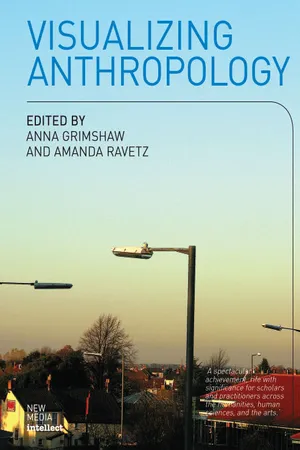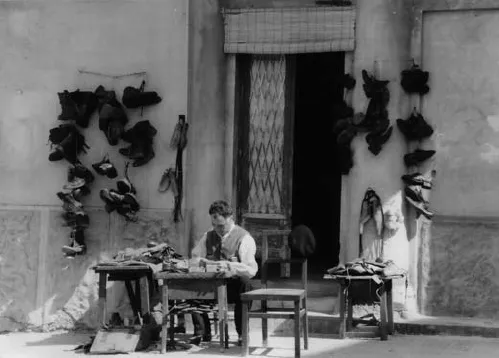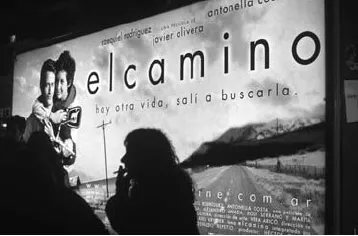
eBook - ePub
Visualizing Anthropology
Experimenting with Image-Based Ethnography
- 167 pages
- English
- ePUB (mobile friendly)
- Available on iOS & Android
eBook - ePub
Visualizing Anthropology
Experimenting with Image-Based Ethnography
About this book
Questions of vision and knowledge are central to debates about the world in which we live. Developing new analytical approaches toward ways of seeing is a key challenge facing those working across a wide range of disciplines. How can visuality be understood on its own terms rather than by means of established textual frameworks? Visualizing Anthropology takes up this challenge. Bringing together a range of perspectives anchored in practice, the book maps experiments in the forms and techniques of visual enquiry. The origins of this collection lie in visual anthropology. Although the field has greatly expanded and diversified, many of the key debates continue to be focused around the textual concerns of the mainstream discipline. In seeking to establish a more genuinely visual anthropology, the editors have sought to forge links with other kinds of image-based projects. Ethnography is the shared space of practice. Understood not as a specialized method but as cultural critique, the book explores new collaborative possibilities linked to image-based work.
Frequently asked questions
Yes, you can cancel anytime from the Subscription tab in your account settings on the Perlego website. Your subscription will stay active until the end of your current billing period. Learn how to cancel your subscription.
At the moment all of our mobile-responsive ePub books are available to download via the app. Most of our PDFs are also available to download and we're working on making the final remaining ones downloadable now. Learn more here.
Perlego offers two plans: Essential and Complete
- Essential is ideal for learners and professionals who enjoy exploring a wide range of subjects. Access the Essential Library with 800,000+ trusted titles and best-sellers across business, personal growth, and the humanities. Includes unlimited reading time and Standard Read Aloud voice.
- Complete: Perfect for advanced learners and researchers needing full, unrestricted access. Unlock 1.4M+ books across hundreds of subjects, including academic and specialized titles. The Complete Plan also includes advanced features like Premium Read Aloud and Research Assistant.
We are an online textbook subscription service, where you can get access to an entire online library for less than the price of a single book per month. With over 1 million books across 1000+ topics, we’ve got you covered! Learn more here.
Look out for the read-aloud symbol on your next book to see if you can listen to it. The read-aloud tool reads text aloud for you, highlighting the text as it is being read. You can pause it, speed it up and slow it down. Learn more here.
Yes! You can use the Perlego app on both iOS or Android devices to read anytime, anywhere — even offline. Perfect for commutes or when you’re on the go.
Please note we cannot support devices running on iOS 13 and Android 7 or earlier. Learn more about using the app.
Please note we cannot support devices running on iOS 13 and Android 7 or earlier. Learn more about using the app.
Yes, you can access Visualizing Anthropology by Anna Grimshaw, Amanda Ravetz, Anna Grimshaw,Amanda Ravetz in PDF and/or ePUB format, as well as other popular books in Art & Art General. We have over one million books available in our catalogue for you to explore.
Information
Arnd Schneider is Senior Lecturer in Anthropology at the University of East London and Senior Research Fellow at the University of Hamburg. He has published on his fieldwork in Sicily and Argentina (Futures Lost, 2000) and the relationship between contemporary art and Anthropology ('On Appropriation', Social Anthropology, 2003). He was co-organiser with Chris Wright of the international conference ‘Fieldworks’ held at Tate Modern, 2003.
Setting Up Roots, or the Anthropologist on the Set: Observations on the Shooting of a Cinema Movie in a Mapuche Reservation, Argentina1
Arnd Schneider
Prelude
One common perception of cinema is that it is an extreme, hyper-real construction of reality. Field sites do not seem to escape this fate; and, in due course, they become locations and, in turn, locations become sites of fieldwork. Rather than thinking of two discrete entities, field sites as observed ‘reality’ here and locations as the places of scripted ‘fictions’ there, both are site specific, constructed realities. From an analytic point of view, we can consider the roles of anthropologist and director in their creative interventions into local realities. The ethnographic research design is comparable to the script, as is the shoot, with its creative derivation from and interpretation of the script. However, in terms of declared aims, there still appears to be a main difference between the field site and location, one is about fact-finding (ethnography) while the other is about fabricating fantasies (cinema). Whilst they might differ in their aims, both the practice and writing of ethnography strive for truth values and verisimilar representations, and so do many genres of cinema. In this sense, both field sites and locations are constructed realities, or ‘hyper real’.2 Field sites and locations are also to some degree interchangeable, the boundaries between them blurring depending on which group of ‘actors’ (artists, ethnographers, cinematographers) interacts within them.

Fig. 1: Salvatore ‘Totò’ Marino on the set of The Sicilian (Michael Cimino, 1987) in Sutera, Central Sicily, 1986. Photo: Nino di Prima.
This situation arose in my first site of fieldwork in Sicily.3 A year after my departure in 1985, the mountain village of Sutera became one the many locations for Michael Cimino’s The Sicilian, starring Christopher Lambert. After the enormous lorries, that hardly fitted into the village square, left Rome’s dream factory, Cinecittà, I returned the following summer, people proudly pointed out to me how the village had been transformed during the shooting. Facades had been painted and locals had participated as extras. One take featured the shoemaker, Totò, repairing shoes on his stool in the piazza. When I saw the finished film, however, there was just a glimpse of him. It was cut indiscriminately against scenes from other unnamed villages in Sicily. The motive of pride, participation and comment for local people became, in the film, just one of many generic picturesque shots without any local reference. People – whose life-worlds and environments have become locations – especially when the story is based on specific historical events or characters (the bandit Giuliano4 in the case of The Sicilian), are usually aware of cinema’s quality to transform the local into a generalised impersonal discourse, dictated by script, commercial interests, and the tastes of the supposed audience (in this case, primarily American and European). Quite different expectations are created, though, when a director promises the people of the location more than just a cursory view or generic representation of their place. If the real name of the place is put forward and is selected as the main location, as was the case of El Camino shot in the Patagonian town of Aluminé, then the local people feel they have become the chosen ones!
1. Introduction
The subject of this chapter is the recent production of an Argentine feature film, El Camino (105 mins., Javier Olivera, 2000). It was shot in part in a Mapuche reservation and in a neighbouring town in Patagonia. The issues I want to address are complex and include the perspectives of the film crew, villagers and indigenous people. The intricate web of politics and ethics of representation which are involved in the practical preparation and execution of shooting in a reservation of indigenous people in Argentina is my principal concern. I also address the political agenda, or ‘indigenism’ of the movie – that is, the explicit aims as they were spelled out to me in meetings and interviews with the director. Thus the main emphasis here is on the production process (especially the shooting) rather than on the finished film which was screened in Buenos Aires and other parts of the country. Finally, I take up the issue of how, as an anthropologist, I became complicit with the film crew. My intention was to be an observer but I became a participant, intervening in the production process.

Fig. 2: Illuminated billboard of El Camino when it was released in Buenos Aires in 2000. (All photographs by Arnd Schneider, except Fig. 1 ).
Research was carried out in April 2000. I accompanied the director, Javier Olivera, and the film crew in Patagonia for ten days. Originally I had approached Olivera in his capacity as a painter who incorporates indigenous symbols into his works; and it was from that first encounter that the opportunity arose to follow the development of his film project, El Camino (figure 2).
2. The film and its background
The story line
El Camino is a ‘road movie’, incorporating elements from the thriller genre with a fast moving story in order to appeal to a young Argentine public. The protagonist, Manuel, is in his early twenties. He is a pensive, good-looking young man from a well-to-do Buenos Aires neighbourhood. He never got to know his father, but a funeral notice for his grandfather in the provincial town of Azul leads him drive there on his motorbike in the hope of meeting his father. Although the father remains elusive, an uncle tells Manuel to search for him in Aluminé (Neuquén Province, Patagonia). On his motorbike, our hero starts a long trip through the Province of Buenos Aires. During the journey many things happen. Manuel falls in love with a young woman, Caro. He witnesses the murder of a young man in police custody and he is pursued by the police officer assassin. Manuel arrives in Aluminé and is reunited with Caro; and together they visit the Mapuche reservation of Ruca Choroi. Manuel’s father, an anthropologist, is absent in Germany; but Casimiro, a Mapuche and good friend of his father, shows him the house and a workshop his father has set up on the Mapuche reservation. Meanwhile, Ferraro, the corrupt police officer has arrived; he searches for Manuel and threatens to kill him. His attempt, however, is foiled by a number of unarmed Mapuche who encircle him and persuade him to put down the gun. Eventually, Manuel gives evidence in a court and Ferraro is convicted.
The film’s agenda
The film’s young director, Javier Olivera, son of the renowned Argentine director Héctor Olivera (best known for his La Patagonia Rebelde, 1974) had already made documentaries for the National Institute of Indigenous Affairs and one feature film (El visitante, 1999), based on the story of a veteran from the Falklands/Malvinas war. In El Camino, Olivera’s aim was to show, as he expressed in various conversations, ‘another reality, contemporary indigenous people’, and to open the eyes of a largely ‘white’, European-descended inhabitants of Buenos Aires and the coastal provinces. Although not called indigenismo in Argentina (as in Mexico or Peru) his motifs were akin to these ideologies, in that he sought to vindicate indigenous otherness from the perspective of the white or Creole (criollo) population. After the 1871 Desert Campaign, in which the Argentine army took territories south of Buenos Aires and in Patagonia, the resistance of the Mapuche was broken. Indigenous people were pushed into reservations, resettled, and above all, marginalised, geographically, economically and culturally.5 In the construction of the nation-state there was no symbolical space for indigenous people, or for that matter, for the few remaining African Argentines.6 Although much mythologised in Argentine arts and literature, a partly indigenous past or present is rarely acknowledged. Film directors, such as Olivera, and other intellectuals are a minority, creative individuals who search for ‘roots’, inspired by past and present indigenous cultures, and who try to convey a political message of cultural resistance. Sometimes this is paraphrased as resistance against North American influence and globalisation. Their perspective, the viewpoint of the urban, ‘white’ porteños, the inhabitants of Buenos Aire, is a construction or appropriation.7 It is not the perspective of indigenous people themselves. Nor is it the approach of indigenous ethnic leaders, some of whom, like Juan Namuncurá (a musician and director of the foundation Instituto de Cultura Indígena in Buenos Aires), were very critical of the film. It is also not the view of the few established indigenous artists, such as the Mapuche singer Pichi Malen, or the video-maker Paula Coliqueo.
The film had several objectives. First of all, it was planned as a commercial project.8 Secondly, it represented an attempt to combine the separate and mutually alien worlds of upper middle-class ‘white’ Buenos Aires, with the interior, the Province of Buenos Aires and the ‘South’, that is Patagonia. But thirdly, and more importantly, the aim was to include the indigenous people of Patagonia, traditionally excluded from Argentine mainstream culture, in the film’s narrative. An analysis of the script and the finished work raises questions about how these images were fabricated, what kind of stereotypes of indigenous people did the film convey and how were they received by the audience. Above all, it is important to ask whether indigenous people were represented differently or whether, once more, they were used just as a picturesque background.
My emphasis here, however, is the process by which reality was fabricated during the shooting of the film, the ethnography off-screen as it was observed first-hand. Of course, the film was also constructed in pre- and post-production; but, apart from interviews with a handful of production executives and editors, I had little opportunity to witness these parts of the process.
On location
By the time I reached the film crew in northern Patagonia in early April 2000, they had been travelling by bus and car through the Province of Buenos Aires for about two weeks. The crew was booked into a huge alpine-style hotel at the outskirts of the village of Aluminé, Neuquén Province. From there a small gravel road led to Ruca Choroi (‘Singing Parrot’), one of the largest Mapuche reservations in the country. Our schedule was first to shoot some scenes in the town of Aluminé. These were to include outdoor shots, street scenes (the arrival of the female protagonist, Caro, at the bus station) and interiors in the supposed house of Manuel’s father as shown to Manuel by Casimiro, his father’s close Mapuche friend.
The story of the making of this film can be told be from different vantage points. In the presentation of my material, I attempt to represent the agendas and expectations of the diverse groups and individuals involved – namely the film crew, the villagers of Aluminé, and the indigenous people of Ruca Choroi.
The crew9
What were the crew’s expectations of shooting in the Mapuche reservation? The crew clearly perceived a difference between the earlier part of the shoot in the Province of Buenos Aires and the final part of the film ...
Table of contents
- Cover
- Fmt
- Copyright
- Title page
- Table of Contents
- Introduction: Visualizing Anthropology
- Eyeing the Field: New Horizons for Visual Anthropology
- Reflections of a Neophyte: A University Versus a Broadcast Context
- Seeing is Believing: An Ethnographer’s Encounter with Television Documentary
- Cameras at the Addy: Speaking in Pictures with City Kids
- News from Home: Reflections on Fine Art and Anthropology
- Give Me a Call
- The Experience and the Object: Making a Documentary Video Installation
- Setting Up Roots, or the Anthropologist on the Set: Observations on the Shooting of a Cinema Movie in a Mapuche Reservation, Argentina
- The Filmed Return of the Natives – To a Colonizing Territory of Terror
- Becoming an Artist-Ethnographer
- Creation and I, Me and My Work: A Personal Account of Relations Between Film, Film-maker and Teaching
- Making Nothing Happen: Notes for a Seminar